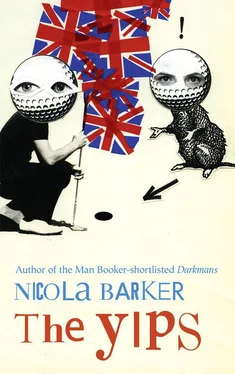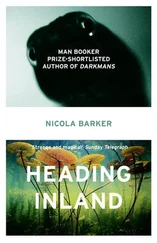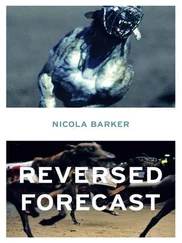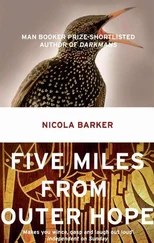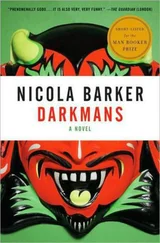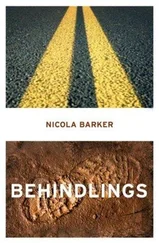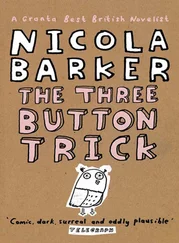Nicola Barker - The Yips
Здесь есть возможность читать онлайн «Nicola Barker - The Yips» — ознакомительный отрывок электронной книги совершенно бесплатно, а после прочтения отрывка купить полную версию. В некоторых случаях можно слушать аудио, скачать через торрент в формате fb2 и присутствует краткое содержание. Год выпуска: 2012, Издательство: Fourth Estate, Жанр: Современная проза, на английском языке. Описание произведения, (предисловие) а так же отзывы посетителей доступны на портале библиотеки ЛибКат.
- Название:The Yips
- Автор:
- Издательство:Fourth Estate
- Жанр:
- Год:2012
- ISBN:нет данных
- Рейтинг книги:4 / 5. Голосов: 1
-
Избранное:Добавить в избранное
- Отзывы:
-
Ваша оценка:
- 80
- 1
- 2
- 3
- 4
- 5
The Yips: краткое содержание, описание и аннотация
Предлагаем к чтению аннотацию, описание, краткое содержание или предисловие (зависит от того, что написал сам автор книги «The Yips»). Если вы не нашли необходимую информацию о книге — напишите в комментариях, мы постараемся отыскать её.
The Yips — читать онлайн ознакомительный отрывок
Ниже представлен текст книги, разбитый по страницам. Система сохранения места последней прочитанной страницы, позволяет с удобством читать онлайн бесплатно книгу «The Yips», без необходимости каждый раз заново искать на чём Вы остановились. Поставьте закладку, и сможете в любой момент перейти на страницу, на которой закончили чтение.
Интервал:
Закладка:
‘Merkins,’ Gene parrots, ruminatively.
‘I got into it by accident,’ she expands. ‘I was offering a cosmetic tattoo service at my dad’s parlour. He’d sent me on a course — learning how to do permanent eye-liner and lip-liner; that kind of stuff. I developed a really good technique for doing eyebrows — for tattooing hair, basically. I did some work on a woman with alopecia and she really loved it. She was quite a character; a performance artist. It was originally her idea for me to tattoo her … well … down there …’
She grimaces. ‘Word quickly got around — especially on the internet. She helped me set up my website. Since then I’ve mainly concentrated on’ — she clears her throat — ‘on what you might call “specialist clients”.’
‘I suppose this gives true meaning to the phrase “a niche market”,’ Gene jokes, lamely.
She glances over at him.
‘Niche,’ he explains, instantly regretting this light-hearted foray, ‘a shallow recess.’
‘A niche?’
She returns her attention back to the photograph again, somewhat perplexed. ‘I’ve never really thought of a vagina in that way before.’
‘Me neither,’ he mutters, humiliated.
‘I’ve done my fair share of nipples — for women who’ve had reconstructive surgery on their breasts. I’m pretty good at them — matching the woman to the nipple; the right size, the right colour. It’s really rewarding work. Bread and butter stuff. I’ve taken a lot of photographs. Some I’m really proud of. I mean I’m quite into scars in general. There’s a specialist scar market — people who want scars’ — she shrugs — ‘and I can do that. I’m into all that …’
‘I had breast cancer myself,’ Gene murmurs.
‘Oh … okay.’ Valentine nods, distracted. ‘It’s not only about the body, though,’ she continues. ‘It started out that way, but now I’m mainly just obsessed by textures,’ she confesses, ‘abstract textures: wools, woven grasses, woodgrains, marble, even concrete. I’ve got this house-brick on my thigh …’
‘A brick?’
His brows rise.
‘A couple of bricks.’ She nods. ‘I tattooed them there myself. I’ve got a photo in my portfolio …’
She walks over to a large, black art folder which leans behind the door, unzips it and then pages through some photographic prints inside. Each piece is separated by a sheet of tracing paper. She eventually locates the one she’s looking for and pulls it out.
‘I’m completely obsessed by Louise Bourgeois,’ she says, carrying it over, the tracing paper still in place. ‘D’you know her work at all?’
He shakes his head.
‘She’s really old now, French, has this huge retrospective coming up at the Tate Modern …’ Valentine glances over, briefly, towards the slumbering Nessa. ‘Not that I’ll get a chance to see it.’ She shrugs.
‘Childcare a problem?’ Gene speculates.
‘Too scared to leave the house,’ she murmurs, smiling.
‘Too scared …?’ he echoes.
‘I’m agoraphobic.’
As she speaks, she places the bottom edge of the print on to the rug, removes the tracing paper and reveals the image for his perusal.
‘Her work deals mainly with issues surrounding women and domesticity,’ she explains (focusing entirely on the photo now), ‘women and the home, basically — women being defined, psychologically, by the actual fabric of their homes. That’s my own, particular area of interest: ideas surrounding intimacy, privacy, anxiety; the textures of my immediate environment — the comfort I find in them and at the same time the feelings of disgust they sometimes evoke in me …’
Gene stares at the photograph as she talks, struggling to process the glut of information she’s feeding him. It is a beautifully taken picture of the left-hand side of her body — from knee to hip. On her thigh are two exquisitely well-tattooed bricks — house bricks, with a thick slick of cement oozing out from between them. Even as he marvels at the extraordinary artistry of her work, he is intensely conscious of the flesh that surrounds it — the quiet, soft canvas of her nudity.
‘Did you take the photo yourself?’ he asks.
‘Yeah. My ex — the monk …’ — she grimaces self-deprecatingly — ‘he was a professional photographer. He left me most of his equipment when he headed off to India. I enjoy dabbling. I use my bedroom as a darkroom. I mean they’re not anything to write home about —’
‘I don’t agree,’ Gene interrupts, ‘I think they’re really wonderful.’
‘I heard this radio interview with her once,’ Valentine continues, returning to her former subject (almost as if embarrassed by Gene’s compliment, although — somewhat paradoxically — seemingly unperturbed by how exposing the photo is). ‘The journalist asked her what her motivation was and she simply answered, “To survive.”’
She shakes her head, fondly. ‘You could hear in her voice — this cracked, dry, old, French voice — that she really, really meant it. She said her art was a way of creating order out of anxiety; making shapes out of this gnawing terror that burrowed away inside of her. I suppose that’s basically what I’m aiming to do myself, but my medium has always been the skin — transforming the skin …’
‘Did it hurt much?’ Gene wonders, seemingly transfixed by the image.
‘It killed!’ She laughs. ‘I have a pathetically low pain threshold.’
‘But you were pleased with the end result?’
She peers down at the photograph, frowning. ‘I guess what most outsiders don’t tend to understand is how little of tattooing — or body art in general — is about the design aspect; the formal decoration. From my perspective it’s always been as much about the process as the end result …’
‘The pain of the needle?’ he muses.
‘Look at the Maoris.’ Valentine nods. ‘For them tattoos are a rite of passage. They’re a marker of bravery, of maturity, of cultural acceptance. The tattoo represents not only a willingness to accept pain — to endure it — but a need to actively embrace it. Because life is painful — beautiful but painful …’
She places the tracing paper back over the image and returns it to the folder. As she does so another print attracts her attention and she pulls it out.
‘Here’s a perfect case in point …’
She carries the print over, places the bottom edge down and removes the tracing paper.
‘This woman was forty-seven when I tattooed her vagina — a widow. D’you see the hundreds of shiny, white marks all over her skin?’
Gene studies the image, closely. ‘What are they?’ he asks. ‘Stretch marks?’
‘Nope. Little cuts. Self-inflicted. She used to slice herself with this special piece of shell …’
Valentine lays the print down flat on to the floor, goes over to her shrine, kneels down in front of it and carefully removes something from behind the picture of Kali. She holds it out to him. He steps forward and takes it from her, gingerly.
‘It’s wonderful to the touch don’t you think?’
‘Is this the actual …?’
He runs his finger over it, appalled.
‘Incredibly cool and light and smooth, but still razor sharp …’
He passes it back to her with a slight shudder.
‘The client had these overwhelming feelings of inadequacy,’ she explains. ‘She’d been raised by an aunt. Her parents had gone to live in America when she was five or six. They’d taken her younger brother with them but they’d left her behind in Japan. She never really knew why. She felt …’
She searches for the right word: ‘… gagged … choked … smothered . She had all these frustrations that she didn’t feel it was socially acceptable for her to express. And crazy as it sounds, some of her deepest feelings of inadequacy were centred on her lack of pubic hair. The other girls at school used to tease her about it, and then, later on, after she was married, her husband did the same. She felt trapped — both physically and emotionally — in this pre-pubescent state …’
Читать дальшеИнтервал:
Закладка:
Похожие книги на «The Yips»
Представляем Вашему вниманию похожие книги на «The Yips» списком для выбора. Мы отобрали схожую по названию и смыслу литературу в надежде предоставить читателям больше вариантов отыскать новые, интересные, ещё непрочитанные произведения.
Обсуждение, отзывы о книге «The Yips» и просто собственные мнения читателей. Оставьте ваши комментарии, напишите, что Вы думаете о произведении, его смысле или главных героях. Укажите что конкретно понравилось, а что нет, и почему Вы так считаете.
